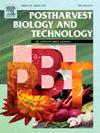Postharvest calcium chloride dips. An effective strategy to reduce Botrytis blight severity and increase petal strength in cut roses.
IF 6.4
1区 农林科学
Q1 AGRONOMY
引用次数: 0
Abstract
Botrytis blight in cut-flower roses is a devastating disease caused by Botrytis cinerea. Calcium (Ca) applications have shown great potential as alternative disease management strategies for different crops. This research aimed to evaluate the effect of preharvest calcium sprays and postharvest calcium dips on rose flower susceptibility to Botrytis blight, petal tissue calcium concentration, and petal strength. Calcium chloride spray applications (0, 500, 1000, and 1500 mg.L−1of Ca) during greenhouse production and postharvest calcium chloride dips (0, 1000, and 2000 mg.L−1 of Ca) were evaluated and compared with commercial controls, including hydrogen peroxide, captan, and pydiflumethophen + fludioxonil. Calcium chloride sprays during production reduced Botrytis blight severity at 500 and 1000 mg.L−1 of Ca; however, no concentration of calcium chloride spray solution increased calcium in the petal tissue. Postharvest calcium chloride dip applications at 1000 and 2000 mg.L−1 of Ca effectively reduced Botrytis blight compared to the untreated control. Calcium chloride dip applications at 2000 mg.L−1 of Ca were effective for increasing the calcium concentration in the epidermis and mesophyll of the petal tissue in comparison to the 0 mg.L−1 treatment and resulted in increased petal strength and reduced Botrytis severity in comparison to captan and hydrogen peroxide treatments. These results show that postharvest calcium chloride dip applications are more effective than spray applications during production in improving calcium concentration and petal strength on roses and result in a reduction of Botrytis blight severity greater than captan and hydrogen peroxide commercial treatments. This underscores the importance of calcium chloride applications as an alternative management approach for Botrytis blight on roses.
采后氯化钙浸泡。降低切花玫瑰灰霉病严重程度和提高花瓣强度的有效策略。
切花玫瑰的灰霉病是一种由灰葡萄孢菌(Botrytis cinerea)引起的毁灭性病害。施用钙(Ca)作为不同作物的替代病害管理策略已显示出巨大的潜力。本研究旨在评估收获前喷洒钙剂和收获后浸蘸钙剂对玫瑰花对灰霉病的易感性、花瓣组织钙浓度和花瓣强度的影响。对温室生产过程中的氯化钙喷洒(0、500、1000 和 1500 mg.L-1 Ca)和收获后的氯化钙浸渍(0、1000 和 2000 mg.L-1 Ca)进行了评估,并与过氧化氢、克菌丹和吡氟噻吩+氟啶脲等商业对照进行了比较。在 500 和 1000 mg.L-1 Ca 浓度下,生产过程中喷洒氯化钙可降低灰霉病的严重程度;然而,任何浓度的氯化钙喷洒溶液都不会增加花瓣组织中的钙含量。与未处理的对照组相比,收获后施用 1000 和 2000 mg.L-1 Ca 的氯化钙浸泡液可有效减少灰霉病的发生。与 0 mg.L-1 的处理相比,2000 mg.L-1 的氯化钙浸泡液能有效增加花瓣组织表皮和叶肉中的钙浓度,与克菌丹和双氧水处理相比,氯化钙浸泡液能增加花瓣强度,降低灰霉病的严重程度。这些结果表明,在提高玫瑰钙浓度和花瓣强度方面,采后氯化钙浸泡比生产过程中的喷洒更有效,与克菌丹和双氧水的商业处理相比,氯化钙浸泡能更有效地降低灰霉病的严重程度。这强调了氯化钙应用作为玫瑰灰霉病替代管理方法的重要性。
本文章由计算机程序翻译,如有差异,请以英文原文为准。
求助全文
约1分钟内获得全文
求助全文
来源期刊

Postharvest Biology and Technology
农林科学-农艺学
CiteScore
12.00
自引率
11.40%
发文量
309
审稿时长
38 days
期刊介绍:
The journal is devoted exclusively to the publication of original papers, review articles and frontiers articles on biological and technological postharvest research. This includes the areas of postharvest storage, treatments and underpinning mechanisms, quality evaluation, packaging, handling and distribution of fresh horticultural crops including fruit, vegetables, flowers and nuts, but excluding grains, seeds and forages.
Papers reporting novel insights from fundamental and interdisciplinary research will be particularly encouraged. These disciplines include systems biology, bioinformatics, entomology, plant physiology, plant pathology, (bio)chemistry, engineering, modelling, and technologies for nondestructive testing.
Manuscripts on fresh food crops that will be further processed after postharvest storage, or on food processes beyond refrigeration, packaging and minimal processing will not be considered.
 求助内容:
求助内容: 应助结果提醒方式:
应助结果提醒方式:


